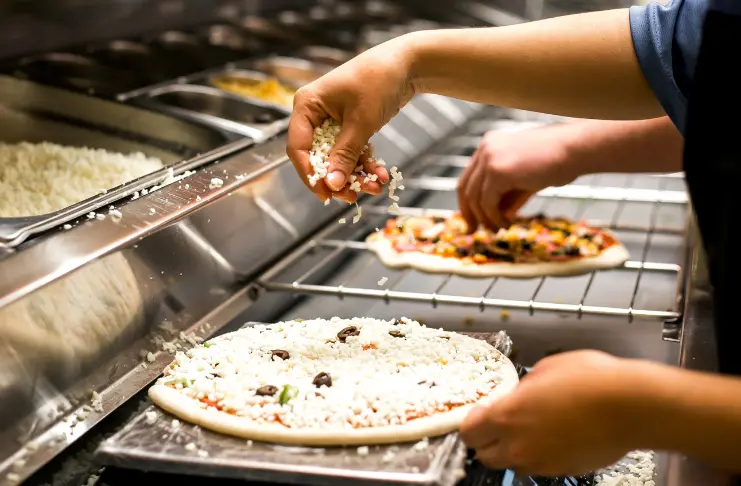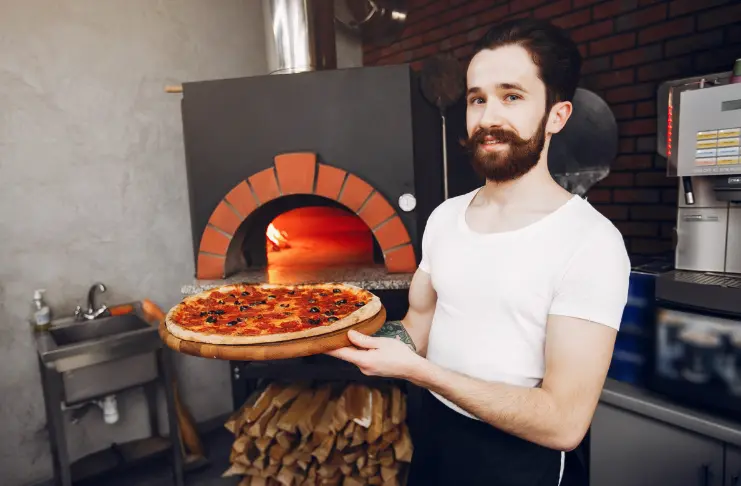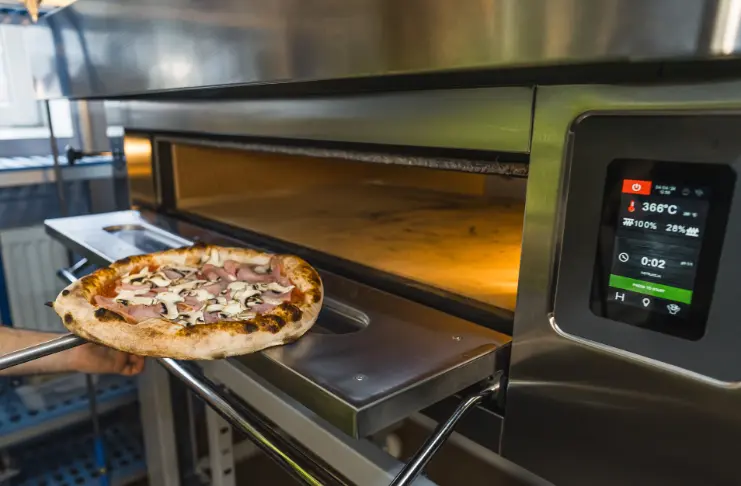
Few segments in foodservice have achieved the scale, consistency, and consumer loyalty that pizza chains have. With streamlined operations, high-volume delivery models, and franchise-friendly formats, they’ve grown into some of the most recognizable and high-growth segments in the restaurant industry.
Over the past year, leading pizza chains have outperformed many other restaurant categories in both revenue growth and customer retention, driven by digital adoption, menu innovation, and expanding access through delivery platforms and non-traditional locations.
This blog dives into the latest pizza restaurant chain statistics shaping the industry, from market share shifts and sales performance to evolving consumer preferences.
Pizza Restaurant Chain Statistics: Market Landscape
The pizza chain segment remains a powerhouse in restaurant dining. Globally, the pizza market was estimated at $150.77 billion in 2023, with projections suggesting growth at 2.8% during 2025-2035 to reach $154.99 billion.
Within the pizza restaurant industry, independent pizzerias make up approximately 40-60% of outlets, yet account for a smaller portion of system-wide revenue. Conversely, the top chains, including Domino’s, Pizza Hut, Little Caesars, Papa John’s, capture the remaining market share, often outperforming independents through consistent branding, operational efficiency, and national reach.
In 2024, chain-operated pizza restaurants generated around $50 billion in annual revenue only in the U.S., with more than 75,000 establishments nationwide.
Key Business Formats
The overall pizza chain industry in the U.S. operates within four key business formats-
1. Delivery-First QSR Models
These chains prioritize off-premise consumption through fast, efficient delivery and carryout, often operating without dine-in seating. The focus is on speed, volume, and operational simplicity. Pizza chains like Domino’s and Papa John’s are examples of this model.
2. Hybrid Dine-in/Takeout
This format offers a combination of traditional table service and takeout/delivery options, making it ideal for diverse customer requirements from family dining to quick pick-up. Pizza Hut is an example of this hybrid model with dine-in venues combined with delivery and take-out services.

3. Value-Driven Carryout Models
These chains focus on high-throughput, ready-to-go pizza formats designed for affordability and speed. For instance, Little Caesars dominates this segment through its “Hot-N-Ready” model, offering pizzas without wait times.
4. Fast-Casual
Fast-casual chains like Blaze Pizza and MOD Pizza have established a niche by offering personalized, premium pizzas in an assembly-line environment. Customers choose ingredients as pizzas are made to order in open kitchens, offering a high-quality, quick, and tailored experience.
Both brands surpassed $270 million in sales, validating the appeal of customizable, fast-casual pizza formats.
Top Performing Pizza Chains in the US

A handful of major players continue to dominate the pizza chain landscape, each carving out its place through unique business models, brand positioning, and strategic innovation. Here’s how the top performers are scaling revenue and expanding footprint in 2025.
1. Dominos
Domino’s remains the undisputed leader in the global pizza chain market. Its success comes from a strong focus on delivery and carryout, backed by a reliable tech stack and franchise-driven expansion strategy.
- Sales revenue: $9.03 billion
- US locations: 6,854
- Global locations: ~20,000
2. Pizza Hut
Once the dominant player, Pizza Hut has shifted from its fully dine-in model toward a more flexible, hybrid approach combining in-store dining, carryout, and delivery. Its investments in “Hut Lanes” in the U.S. (drive-thru for digital orders) and global menu innovation have helped maintain relevance across diverse markets.
- Sales revenue: $5.6 billion
- US locations: 6,593
- Global locations: 19,000
3. Little Caesars
Little Caesars has built a solid presence by keeping things simple. With its value-driven “Hot-N-Ready” model, the chain thrives on affordability, speed, and minimal wait times, appealing to budget-conscious families and busy customers.
- Sales revenue: $4.43 billion
- US locations: 4,217
- Global locations: 5,500
4. Papa John’s
Papa John’s has been undergoing a strategic shift to refine its core menu, improve franchisee margins, and differentiate through premium ingredients. While the brand has been facing a slowdown recently, it remains a key player with a loyal customer base.
- Sales revenue: $3.86 billion
- US locations: 3,320
- Global locations: 6,000
5. MOD Pizza
MOD Pizza has established a strong identity in the fast-casual segment with its build-your-own format and quick service. Focused on personalization and speed, the brand appeals to younger, urban consumers looking for high-quality yet affordable pizza.
- Sales revenue: $659 million
- US locations: 552
Pizza Restaurant Market: Consumer Insights

The pizza restaurant market in the U.S. is a highly competitive segment, mainly due to its broad customer appeal, affordability, and ability to customize according to individual tastes. Here’s how diverse consumer preferences are shaping the pizza restaurant industry-
- About 25% of U.S. consumers eat pizza two or more times a week, with higher consumption among Gen Zs and Millennials, indicating consistent demand across demographics.
- In a survey, roughly two-thirds of Americans reported eating pizza in the past week, with 87% saying they are eating the same or more pizza than the previous year.
- 51% of pizza lovers agree that pizza is an indulgent meal and prefer it with healthy ingredients, highlighting the consumer’s appetite for balance.
- 28% of diners prefer thin-crust pizza, followed by stuffed (20%) and thick crust (14%).
- 44% of diners say they would try pineapple on pizza, revealing openness to unconventional toppings.
- 78% of pizzerias in the U.S. accept online orders, with 44% of those reporting that digital channels account for at least 28% of sales
- Over 70% of consumers believe pizza from restaurants is better than frozen pizza, giving food service operators a competitive edge.
Key Trends Shaping the Pizza Restaurant Industry
1. Digital Ordering and Delivery
Consumers are increasingly preferring online food delivery channels and takeout options over dine-in, owing to the convenience they offer. About 70% of customers prefer ordering online for delivery, and online pizza orders typically include 18% higher consumer spending than phone-in orders.
The rise of digital channels directly impacts order frequency and average check value. Consumers are more likely to place larger, more customized orders online due to visual upselling and bundled promotions.
2. Technology Integration in Kitchens
To handle high volumes of orders, pizza chains are turning to automation, such as smart POS systems, conveyor ovens, or digital ordering enhancements. Conveyor ovens alone are projected to grow from $1.67 billion in 2024 to $4.15 billion by 2035, supporting faster, more consistent cooking.
Additionally, more than 60% of Pizza Hut dine-in orders in the UK are taken using customer-facing terminals, and the brand is rolling out kiosks and mobile QR ordering across its U.S. locations.

3. Rise of Self-Service Kiosks
Self-service kiosks in pizza chains reduce dependency on front-of-house staff and shorten wait times, helping chains operate more efficiently during peak times. By automating order entry, brands can reassign staff to food prep or quality control, improving service quality and reducing human error.
4. Demand for Sustainability
Consumers expect their pizza to reflect wellness and environmental values. A recent report highlights growing demand for locally sourced, organic ingredients in pizza chains, driven by transparency and eco-consciousness.
As a result, chains are responding by offering gluten-free, vegan, and fewer processed ingredients to meet clean-label demand.
5. Growing Interest in Unique Flavors
Diners are seeking innovative toppings, unique flavors, and international tastes in their pizzas. As a result, pizza chains are experimenting with global cuisines and trends to stand out and engage customers.
From Indian tikka and curry flavors to kimchi pizza or peri-peri paneer toppings, new flavors are appealing to diverse palates and younger demographics seeking unique experiences.
EXPERT OPINION
Bobby Lawson, publisher and technology editor at Earthweb, an online publication, says, “The rapid advancement of artificial intelligence … will revolutionize not just the tech industry but the restaurant industry as well, and pizzerias are no exception.
For marketing, AI can be used for personalized customer engagement. They [Restaurants] can use artificial intelligence to collect data about customer feedback, order history, and preferences. They can then use this to create a more personalized marketing campaign and send emails with recommendations based on the customer’s order history and preferences.
Conclusion
Growth in the pizza restaurant space increasingly hinges on how well brands balance consistency with innovation. It’s no longer enough to dominate with footprint or price; winning operators are those who align formats with local markets, experiment with diverse flavors to match emerging tastes, and invest in technology.
Most importantly, staying updated with the latest trends and pizza restaurant chain statistics will ensure that independent owners and chain operators maximize their growth in this scaling market.
Frequently Asked Questions
Domino’s is the top-selling pizza chain globally, with over $9 billion in U.S. sales and over 20,000 stores worldwide as of 2023.
As of 2024, there are over 75,000 pizzerias in the US.
Domino’s is the world’s largest pizza chain in terms of revenue and unit count. It operates in over 90 markets, driven by a franchise-heavy model and consistent global sales growth for over 60 years.
The U.S. pizza market is highly competitive, with thousands of independents and a few dominant chains vying for share. It is a fast-moving space where brand differentiation and operational efficiency are critical for success.








